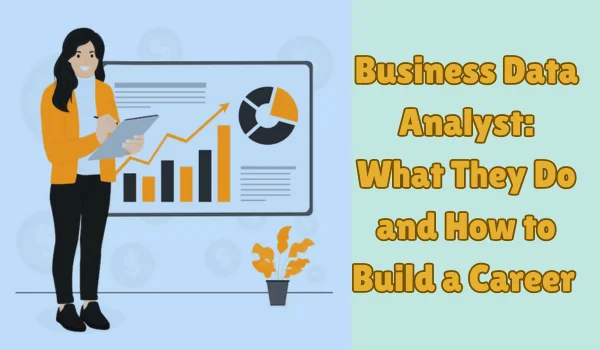In today’s data-driven world, where every click, purchase and interaction leaves a footprint, businesses are asking a bold question: What story does our data tell? If you’ve ever imagined being the detective behind that story, unravelling patterns, translating numbers into decisions, then the role of a business data analyst might be for you. It’s no surprise that professionals coming out of top programmes think of your XLRI Courses or equivalent are increasingly charting this path. As we edge into 2026, the role isn’t just about spreadsheets and dashboards anymore, it’s about strategic insight, business impact and being a key player in decision-making.
What Does a Business Data Analyst Do?
A business data analyst occupies an intersection between raw data and business strategy. According to career guides, their primary purpose is to extract meaningful insights from data and then collaborate with business stakeholders to translate those insights into actionable steps.

Here’s what that typically involves:
- Gathering and cleaning data from multiple sources, databases, spreadsheets, and APIs to ensure accuracy and consistency.
- Analysing the data: finding trends, anomalies and patterns. This often involves SQL, Excel, Python/R and visualization tools like Tableau or Power BI.
- Building dashboards and reports that clearly communicate business metrics (KPIs) and performance across functions like sales, marketing, operations.
- Working with business units, such as product, operations, finance, to define metrics, translate questions into data tasks, and provide recommendations for optimization.
- Helping drive strategy: by interpreting data, a business data analyst can highlight opportunities (e.g., “Our churn is rising because of X”), propose interventions, and measure outcomes.
Why the Role Is Crucial in 2026
As we approach 2026, the role of business data analysts is changing—and expanding. Data volumes continue to explode, business environments are more complex, and organisations expect faster, more strategic insights. Consider the following shifts:
- Businesses are less tolerant of “just reporting”. They expect analytics to drive decisions and business value.
- With technologies like AI and machine learning increasingly embedded, analysts now need to complement tools with business sense and communication.
- Domain knowledge, understanding the business context, industry trends, regulations has become as important as technical finesse.
In short, the business data analyst of 2026 isn’t just a number-crusher; they’re a translator between data and strategy, a storyteller, a partner in business growth.
Key Skills for 2026
Here’s a breakdown of the skills you’ll want to master if you’re aiming for a career as a business data analyst in 2026:
- Technical & Tool-Based Skills
- SQL remains foundational: querying relational databases, joining tables, aggregating results.
- Visualization tools (Tableau, Power BI) to turn data into interactive dashboards.
- Programming languages (Python/R) for more advanced analysis, automation or modelling.
- Data cleaning and preparation: because raw data is messy, inconsistent, incomplete.
- Business & Analytical Acumen
- Understanding business processes, KPIs and how data ties into business goals.
- Problem-solving: framing a business challenge, defining the question, analysing the data and providing actionable recommendations.
- Communication: translating complex data findings into clear, compelling narratives for stakeholders.
- Emerging Skills for 2026
- Some predictive analytics: not just describing what happened, but what could
- Domain specialization: e.g., analytics in fintech, supply chain, healthcare knowing the business context.
- Data storytelling and visualization sophistication: telling the right story, not just creating charts.
- Collaboration skills: working cross-functionally, influencing without authority, presenting to senior leadership.
How to Build Your Career – Step by Step
If you’re aiming to become a business data analyst by 2026 (or grow further in the role), here’s a roadmap:
Step 1: Foundation & Education
Start with a solid base whether a bachelor’s degree in a relevant field (business, statistics, computer science) or certificate programmes. Supplement this with hands-on learning: SQL, Excel, visualization tools.
Step 2: Build Practical Skills & Portfolio
Practice matters. Build sample dashboards, take public datasets and analyze them, create a portfolio of projects. Employers look for a demonstration of ability, not just theoretical knowledge.
Step 3: Get Business Exposure
Try to work on business problem statements: what drives revenue, what influences customer behaviour, what operations costs is rising. The ability to ask the right question is as important as knowing the tool.
Step 4: Move from Reporting to Insights
Reporting is necessary but basic. Aim to go beyond “what happened?” to “why did it happen?” and “what should we do?” As you progress, you’ll start influencing strategy, not just aggregating numbers.
Step 5: Specialize & Grow
Choose a domain or vertical that interests you retail, logistics, SaaS, healthcare, etc. Master the KPIs and metrics unique to that domain. At the same time, enhance your skills in predictive analytics, experiment design (A/B testing), or machine learning basics.
Step 6: Communicate and Lead
As you gain experience, you’ll work with stakeholders, present to managers, influence decisions. The stories you tell with data will matter. You might mentor junior analysts, lead analytics initiatives, or manage dashboards for entire business units.
A Real-World Example to Bring It to Life
Meet “TrendMart”, a mid-sized e-commerce company. They observe that although traffic is increasing month-on-month, the repeat purchase rate is stagnating. They bring on a business data analyst, Sam. Sam digs into the data: segmenting customers by purchase frequency, lifetime value, browsing behaviour. Using SQL and Python, he finds that customers who abandon items in cart but return within 3 days have a 40% higher lifetime value than those who check out immediately.
Sam builds a dashboard (Power BI) that visualizes cohorts, conversion timelines, and customer drop-off points. He recommends a follow-up email campaign and loyalty incentive based on the abandonment segment. Six months later: repeat purchase rate climbs by 12%, average lifetime value increases by 7%. Sam’s work moved beyond reporting metrics, it created business impact. This is the kind of story that defines the 2026 business data analyst.
Career Progression & Outlook
In terms of progression, many start as junior analytics or business-insight roles, then move into senior business data analyst, analytics lead and ultimately analytics manager or business intelligence director. With experience, you shift from doing analysis to driving strategy, influencing business outcomes and leading teams. Demand for analysts is strong across industries from fintech to supply-chain, healthcare to marketing because every sector wants to make data-driven decisions.
Salaries and opportunities continue to grow. But again: it’s not just about titles it’s about value. The analysts who combine technical chops, business insight and storytelling will be most in demand in 2026 and beyond.
Conclusion
If you’re looking for a career that blends technology, business and impact a role where you’ll uncover hidden patterns, influence decisions and drive growth then the role of a business data analyst is where you should aim. Start building your skills, work on real projects, hone your business understanding, and stay curious about what data can tell you. For those ready to commit, enrolling in a structured programme like a PG in business analytics can give you the momentum to launch and accelerate your journey.

Hello, I’m Kapil Kumar, a seasoned SEO expert and blogger at WinnersList.in. My mission is to spotlight exceptional individuals and organizations across various domains. Through curated lists, profiles, and inspiring stories, I aim to celebrate outstanding achievements and inspire the next generation of champions. Join me in this journey.
